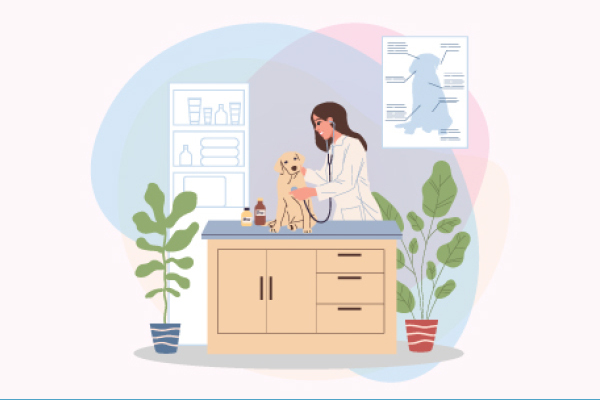The Do’s and Don’ts of Veterinary Websites
Your website is a digital impression of your veterinary practice and it should accurately reflect who you are as a business. Having a modern website that makes it as simple as possible for potential clients to learn what pet services you offer or quickly book appointments with veterinary professionals in your office is essential.
But, designing a site to have the look and feel that you want can be tedious work. It takes time to figure out which ideas work best for your website and which ones should be scrapped. That’s why we’re here to help you make those tough decisions.
Businesses will sometimes make common mistakes that deter visitors from exploring or staying on their website any longer. But we’ll be going through the do’s and don’ts of veterinary websites to help you avoid these errors. Let’s dive in!

DO: Make Your Website Easy to Navigate
You don’t want to design a website that is difficult for current and potential patients to find exactly what they’re looking for. If you don’t have proper navigation on your website, visitors won’t be able to find your blog, phone number, services, or other relevant information.
In order to avoid confusion on your vet site, set up a navigation bar that has all of the main pages of your website. These pages should be hypervisible and easily accessible from anywhere on the site as it is part of your primary navigation.
For example, is your veterinary practice focused on booking more appointments? Then the link to your booking page should be front and center. Do you want visitors to know what services you offer? Assign that page as a priority in your main menu. Make it simple for pet owners to seamlessly maneuver throughout your website in order to generate the best results for your practice.
Here are a few tips that we recommend for your navigation:
- Make it possible for visitors to reach any page from every page on your site
- Add a search bar
- Consider a sticky menu (the menu will remain in the same position and be visible when a user scrolls and no matter where they are on the site)
- Link your veterinary logo back to your homepage
Learn More: The Best Veterinary Website Designs For 2021
DON’T: Add Too Many Options to Your Navigation Bar
The goal is to keep visitors on your website as long as possible and eventually book an appointment, but you don’t want to confuse users or put far too many options on your primary main menu.
Choose the most important pages that you would like to appear at the top of your website. You want to avoid overwhelming users with options, especially when they’re looking for something specific on your site.
It is suggested that you limit the number of items in your navigation bar between three and six choices.
Jimdo
When deciding on the hierarchy of your web pages, prioritize them by what actions you want clients to take and what would help you produce the results you want to see.
DO: Choose a Professional and Modern Design For Veterinary Websites

It’s important to consider every element of your website to maximize your revenue as well as provide a satisfying client journey.
These elements can make or break your website:
- Color Scheme for Your Web Design – Different colors evoke different emotions in human beings so you need to carefully choose complementary colors for your site. What do you want visitors to feel when they enter your website? Who is your target demographic? How many colors do you want for your website? These are all important questions to ask yourself before picking your color scheme.
- Font Size – Make sure that the font size you select is a size that is legible enough for users to be comfortable reading it. Also, be consistent and choose a few fonts that you will be using throughout the entirety of your site.
- Copy – Your copy tells users who you are, what your is about, what veterinary services you offer, and how to contact you. Don’t leave potential clients wondering what is it that you do after looking at your site.
Be cognizant of these elements of your website while also avoiding a few others.
Try to avoid using these:
- Scrolling text (text that moves on the web page)
- Flashing intros (a homepage that flashes when you first enter the website)
- Extremely bright or hard to see colors
DON’T: Forget To Optimize Your Website For Speed and Performance

Although it’s important to add the features you want to your site, remember to not overload it so much that it loads too slow. If it takes too long to load your homepage, visitors may be inclined to leave.
Slow page speed can lead to a higher than average bounce rate as well as negatively impacting your Google ranking. Speed is one of the indicators that Google’s algorithm uses to determine your page rank. Therefore, you want your content to load as quickly as possible to keep potential clients on your page.
To avoid your website taking longer than the average time of 10.3 seconds on desktop and 27.3 seconds on mobile, try these tips:
- Compress and optimize images
- Reduce redirects
- Remove javascript
DO: Take The Copy on Your Website Seriously and Create Quality Content
The text that appears on your website is just as important as the design. The content on your website needs to include keywords that are relevant to the veterinary industry and what your potential clients are searching for online.
The quality of your copy and how much of it is on your website is beneficial in improving your SEO, generating more online traffic, and attracting your ideal clients to your practice. By using keywords to explain your services, adding a blog, writing short bios for the team members at your veterinary hospital, having homepage copy, etc., you’re adding to the quality of the text on your site.
Do the necessary research to discover what pet owners in your local area are searching for and write copy with those keywords included.
Some examples of common search queries involving veterinarians include:
- Vet or veterinarian near me
- Emergency vet
- Animal hospital
- Pet dental services
- Veterinary services
Read On: Veterinary SEO: How to Improve Your Practice’s Local Ranking On Google
DON’T: Keyword Stuff to Attempt to Rank Better on Google

Although you want your practice to show up in the Google search rankings and other search engines, you don’t want to keyword stuff in order to do so. Keyword stuffing is an SEO technique that refers to loading or “stuffing” a webpage with keywords in an effort to rank higher in the results pages of search engines. Businesses will do in an attempt to boost their search visibility.
Google’s algorithm is very smart and can tell when you are attempting to keyword stuff in order to appeal to them. It is highly condemned and this can kill your website’s SEO. Your website can even be penalized for doing so.
Be sure to focus on adding keywords to your website when it is relevant and where they will actually add value to your content. Put your targeted keyword in the right place in your content where it makes sense. When you create useful content full of information about pet health for potential clients, use those keywords appropriately in your text.
Additional Tips for Veterinary Websites
Now that we’ve covered the most important do’s and don’ts for your website, here are a few extra tips to help you construct a site that gets the job done!
- Don’t forget the importance of visuals for your site. Adding quality imagery improves user experience as well as the look of your website. (You get bonus points if you have photos of yourself with pet patients!)
- Include your social media handles in your header or footer.
- Prioritize simplicity regarding the language on your site. Be as clear as possible so users understand.
- Make your website compatible with mobile devices. A large number of potential clients will be viewing your site on their mobile devices, which means it needs to provide the same experience as it does on a desktop. With a mobile-responsive design, you won’t have to worry about your website preventing mobile users from exploring your website.
Let VetMatrix Handle the Veterinary Web Design and Marketing for Your Vet Clinic
Designing your website to be exactly how you want it can be difficult but VetMatrix can do it for you! We can work together to create a unique site tailored to your needs. Book a consultation or call 888.792.8384 to get a website that is tailored to your practice.



